| Use of Cassava as Animal Feed |
Potential of cassava in integrated
farming systems
T R Preston
University of Tropical Agriculture
Foundation,
Chamcar Daung, Phnom Penh, Cambodia
Abstract
A considerable amount of new research information about the
use of cassava as animal feed is becoming available from ongoing research in
Vietnam, Thailand and Cambodia.
Previously, cassava has been characterized as an “exploitive” crop,
destructive of soil fertility. However, when cassava is grown as a component of
a farming system, in which live stock and crops are closely integrated, its capacity to “exploit” the
nutrients in live stock manure becomes a valuable asset.
Cassava can produce very high yields, especially of protein (up to 4 tonnes/ha/year), which make it an ideal element for taking advantage of live stock wastes. The results are encouraging and lay the basis for future research and development activities that promise to have a major impact in tropical farming systems.
Key words: Cassava, integrated farming
systems, foliage, livestock, recycling
Introduction
The role of cassava in integrated farming systems is closely linked with two major issues that must be addressed in the course of this century. The first issue is the need to control global warming which, according to one authority (ref..2001), will require halving the present rate of consumption of fossil fuel in order to stabilize atmospheric concentrations of carbon dioxide. This is possible if we have the will to make optimum use of natural resources, the most important of which is solar energy. There is more than enough energy coming from the sun to cover our needs for food and fuel (Figure 1). The second issue is the need to improve the environment and to reduce pollution. The question then is: how can the cultivation and utilization of cassava become a part of the above strategy?
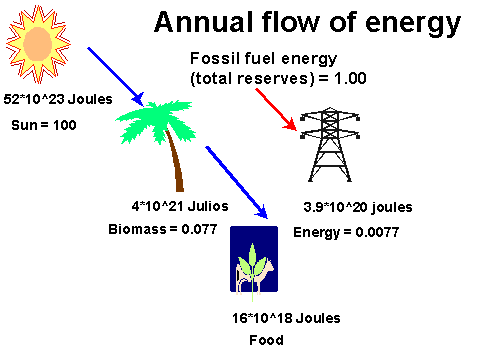
Figure 1:
Annual flows of energy from the sun and the quantities fixed as biomass and
food
compared with known fossil fuel reserves and annual energy consumption
Cassava as a dual purpose crop
Cassava has one important characteristic, namely that it can
be managed to maximize production of carbohydrate (in the form of the roots),
or protein, by harvesting the
leaves. For root production the growth
cycle is from 6 to 12 months at the end of which the entire plant is
harvested. When maximum protein
production is the aim, the foliage is harvested at 2 to 3 month intervals by
cutting the stems at 50 to 70 cm above the ground thereby encouraging the plant
to re-grow. In this case the roots act
as a nutrient reserve to facilitate the re-growth of the aerial part. This
process can continue for 2 to 3 years if the nutrients exported in the leaves
are recycled as fertilizer.
Dual-purpose production systems are also possible whereby one or two
harvests of the leaves are taken before the plant is allowed to continue the
normal development of the roots.
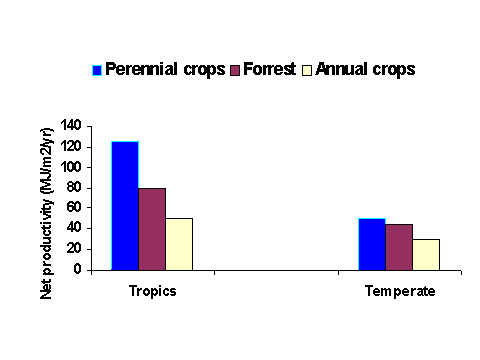
Figure 2:
Biomass yield from different ecosystems (Source: Kormondy 1970)
Cassava as a perennial forage
In tropical ecosystems, the cultivation of perennial crops
is the most efficient way to fix solar
energy in the form of biomass (Figure
2). Thus the management of cassava as a perennial forage is one way of
responding to the need to use solar energy more efficiently. Growing and using cassava as a perennial forage
was first proposed by Moore (1976) based on observations at CIAT in Colombia
(Moore 1976). High yields of foliage were obtained when cassava was managed as
a semi-perennial crop with repeated harvesting of the foliage at 2-3 month
intervals. This idea was taken up in
the Dominican Republic by Ffoulkes and
Preston (1978) who showed that the fresh foliage could be used as the sole
source of protein and fibre for supplementing a liquid diet of molasses-urea
for fattening cattle. Growth rates were over 800 g/day and were not
improved when 400 g/day of additional soya bean meal was given. However,
although successful at the level of the animal the system could not be
sustained agronomically. Yields of foliage fell rapidly with successive
harvests and were negligible by the fourth harvest, due to a lack of
appreciation of the need to return to the soil the considerable amounts of
nitrogen and other nutrients removed by repeated harvesting (T R Preston,
unpublished observations).
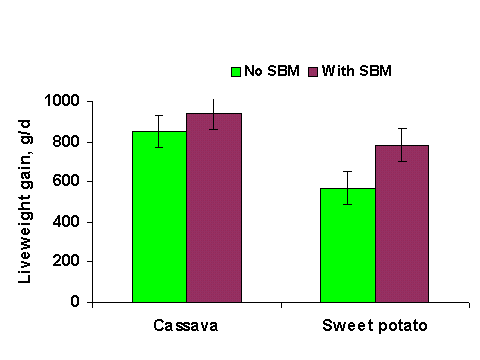
Figure 3:
Cassava foliage is a better source of bypass protein than sweet potato vines in
a
cattle fattening diet based on ad
libitum molasses-urea (Ffoulkes
and Preston 1978)
More recent research, first in Vietnam (Preston et al 2000) then in Cambodia (San Thy and Preston 2001, unpublished data), has demonstrated that the cassava plant can be maintained as a semi-perennial forage crop for at least 2 years provided there is heavy fertilization either with goat manure (Figure 4) or with the effluent from biodigesters charged with pig manure (Figure 5).
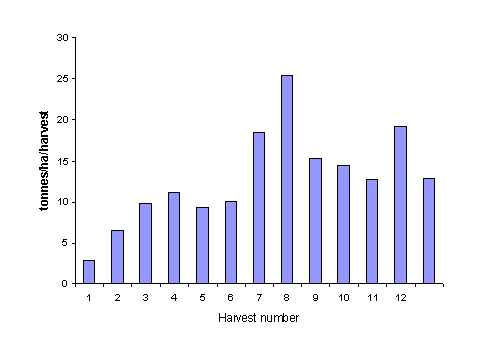
Figure 4: Fresh
foliage yields of cassava managed as a semi-perennial forage crop with repeated
harvests at 50 to 70 day intervals and
fertilized with fresh goat manure
(20 tonnes/ha/harvest) (Source: Preston et al 2000)
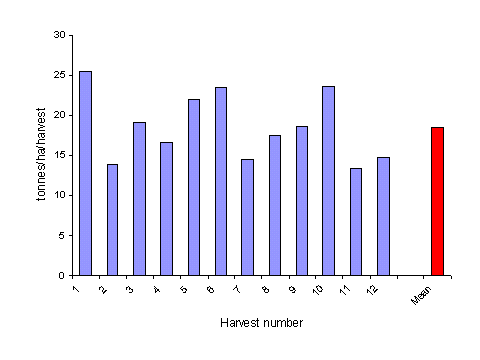
Figure 5: Fresh
foliage yields of cassava managed as a semi-perennial forage crop in Cambodia
with
repeated harvests at 50 to 70 day intervals and fertilized with biodigster
effluent
(100 kg N/harvest) (Source: San Thy and Preston 2001, unpublished data)
Cassava and manure recycling
In countries with industrialized agriculture the disposal of
manure from large scale livestock units situated close to urban areas has
become a major problem (Narrod 2001). This situation is exacerbated by the
restricted growing season in temperate latitudes where industrialized livestock
production is concentrated. For example, in Germany the maximum amount of
nitrogen that can be applied as manure is only 170 kg N/ha/year. Tropical
counties with year-round growth potential do not have this problem. Livestock
manure is a major asset and crops such as cassava are capable of taking up as
much as 1000 kg N/ha/year in the form of fresh livestock manure or effluent
from biodigesters (Preston T R, 2001 unpublished observations).
The processing of livestock manure in biodigesters results
in the conversion of much of the organic nitrogen to ammonia (Khieu Borin and
Preston T R 2001, unpublished data). This makes the biodigester effluent a
potentially better source of plant nutrients than the manure from which it is
derived. Data in support of this
hypothesis was reported by Le Ha Chau (1998) who showed that the effluent
supported higher yields of foliage with a higher protein content than the raw
manure (either from cattle or pigs) used to charge the biodigesters.
Cassava as a source of biomass energy
Irrespective of whether cassava is grown for root or forage
production, a considerable part of the biomass is present in the stem. Some
stem material is needed as cuttings for re-establishing the crop, however, when
it is grown as a perennial forage this requirement is much reduced as the plant
will continue to produce from the same root stock for at least 2 to 3 years,
provided there is an adequate supply of nutrients.
The cassava stem is a potential source of energy and has been used successfully as a
fuel source in a downdraft gasifier (Dinh Van Binh and Preston, unpublished
observations). Cassava as source of fuel (the stems) and protein (the leaves)
is a logical complement to energy-rich sugar cane in a co-generation system to
provide energy and animal feed (Table 1) from high biomass crops.
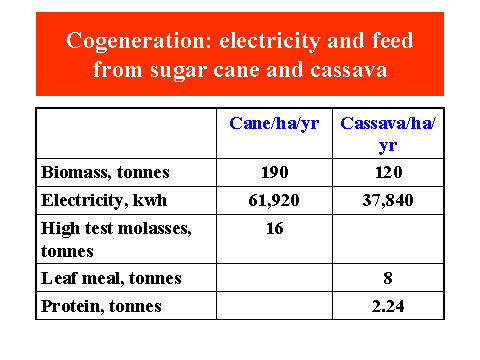
Table 1:
Potential for production of electrical energy (by gasification of residual
fibre
from sugar cane and cassava) and feed
energy and protein (high test sugar cane molasses
and dehydration cassava leaves) in a co-generation system
Cassava foliage as animal feed
Recent work in Cambodia has aimed to evaluate cassava as a protein supplement for cattle and goats (the fresh foliage) and pigs (the ensiled leaves). The latter aspect is discussed by Ly and Rodriguez (2001) in a companion paper. In contrast with the cassava research programme in Thailand, which is mainly based on production and utilization of cassava hay for dry season feeding (Wanapat 2001), in Cambodia the emphasis is on use of the fresh foliage on a year-round basis. Results from feeding fresh cassava foliage as a supplement to Brewer’s grains for goats are summarized in Figures 6 and 7. There were positive effects of the cassava foliage in reducing nematode worm burdens (Figure 6) and in supporting growth rates (Figure 7). For cattle the emphasis is on the use of the cassava foliage to supplement untreated rice straw as a fattening system for local Yellow cattle. The results are encouraging, especially when the cassava foliage was combined with a single drench of vegetable oil at the beginning of the fattening period (Figure 8).
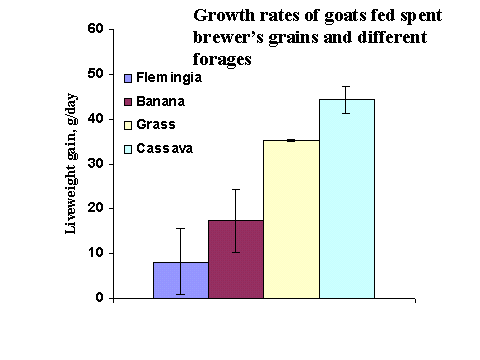

Figure 7. Effect of tree foliages on growth rate of goats
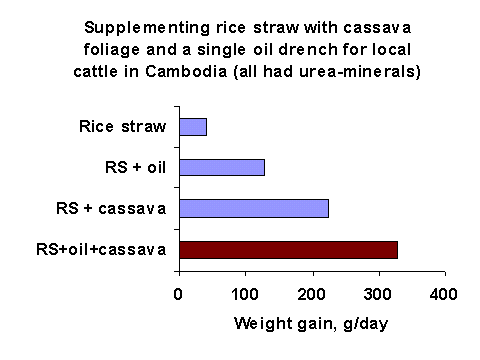
Figure 8:
Supplementing rice straw with cassava foliage and a single oil drench
for local cattle in Cambodia (all had
urea-minerals)
Conclusions
A considerable amount of new research information about the
use of cassava as animal feed is becoming available from ongoing research in
Vietnam, Thailand and Cambodia.
Previously, cassava has been characterized as an “exploitive” crop,
destructive of soil fertility. However, when cassava is grown as a component of
a farming system, in which live stock and crops are closely integrated, its capacity to “exploit” the
nutrients in live stock manure becomes a valuable asset.
Cassava can produce very high yields, especially of protein
(up to 4 tonnes/ha/year), which make it an ideal element for taking advantage
of livestock wastes. The results are
encouraging and lay the basis for future research and development activities
that promise to have a major impact in tropical farming systems.
References
Ffoulkes D and Preston T R 1978 Cassava or sweet potato forage as combined sources of protein and roughage in molasses based diets: effect of supplementation with soybean meal. Tropical Animal Production (3) :186-192
Kormondy E J 1969 Concepts of ecology. Prentice-Hall;
Engelwood Cliffs NJ, USA
Le Ha Chau 1998 Biodigester effluent versus manure from pigs or cattle
as fertilizer for production of cassava foliage (Manihot esculenta). Livestock
Research for Rural Development. (10) 3: http://www.cipav.org.co/lrrd/lrrd10/3/chau1.htm
Narrod Clare 2001 Comments from LEAD. In: Electronic conference on area wide integration of crop and livestock
production. FAO, Rome Clare.Narrod@fao.org
Preston T R,
Rodriguez Lylian and Khieu Borin 2000 Associations of
cassava and legume trees as perennial forage crops for livestock.
Workshop-seminar "Making better use of local
feed resources" January, 2000. SAREC-UAF (Editors: T R Preston and R B
Ogle). UAF, Ho Chi Minh City , Vietnam
Seng Sokerya and Rodríguez Lylian 2001 Foliage from
cassava, Flemingia macrophylla and bananas compared with grasses as forage
sources for goats: effects on growth rate and intestinal nematodes. Livestock
Research for Rural Development (13) 2: http://www.cipav.org.co/lrrd/lrrd13/2/sok2132.htm
Seng Mom, Preston T R, Leng R A and Meulen U ter 2001 Response of young cattle fed rice straw to supplementation with cassava foliage and a single drench of cooking oil. Livestock Research for Rural Development (13) 4: http://www.cipav.org.co/lrrd/lrrd13/4/seng134.htm
Wanapat M 2001 Role of cassava hay as animal feed in the tropics. International Workshop on Current Research and Development on Use of Cassava as Animal Feed. (Editors: T R Preston, Brian Ogle and M Wanapat). MEKARN (SAREC) and Khon Kaen University. http://www.forum.org.kh/~mekarn/prockk/wana3.htm